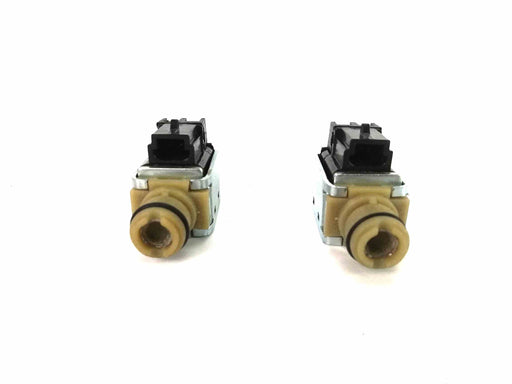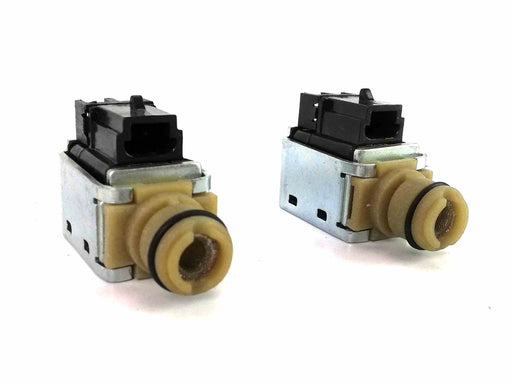
Automatic Transmission Solenoids: Everything You Need to Know
Solenoids are electro-hydraulic valves that control the transmission’s flow fluid. They are a very important component of the transmission that opens and closes according to electrical signals they receive from the vehicle’s engine or transmission control unit and draws data from the engine speed sensor.
While the clutch controls when and how to shift gears in a manual transmission vehicle, the solenoids are part of the automatic transmission’s complex system that performs the same task; therefore, a faulty solenoid can cause hydraulic system problems, leading to costly repairs.
What are automatic transmission solenoids?
The transmission solenoid, or solenoid pack, is a type of electromagnetic valve whose function is to control the Automatic Transmission Fluid, ATF flow, or transmission flow. Solenoids are usually installed in packages in the transmission control unit or valve body. If the flow path is hindered, the transmission will not work properly.
ATF controlled by solenoid valves pressurizes the transmission bands and clutches, making gear changes easier.
Automatic Transmission Solenoid Types
In automatic transmissions, there are different types of solenoids, such as:
- Lock solenoids. It´s role is to block the passage of energy.
- Control solenoids. It´s a type of valve that controls the pressure in the transmission to ensure the system´s performance.
- Shift solenoid. They are valves that operate dipped in the transmission fluid and control gear changes.
- Torque converter clutch solenoid. It´s a valve that prevents the ATF from escaping and losing pressure, preventing the transmission from overheating.
How Do Transmission Solenoids Work?
Inside the car's engine, sensors constantly monitor operation and analyze what needs to be adjusted. When a vehicle needs to change gear, the sensors send signals to the transmission control unit, which in turn signals the solenoids to open or close and allow the gear change to take place.
Shift solenoids have a spring wrapped with a wire inside, which connects to the speed sensors and the transmission control unit. That way the transmission signals can be received.
Information transmitted by the transmission control unit allows upshifts/downshifts to be executed through a signal to one of the solenoids so that the plunger opens and ATF flows into the valve body and pressurizes bands and clutches to make the gear change.
The vehicle's computer controls the solenoids in different ways. For example, they can be open or closed through a direct 12v signal, control one or more gears, or switch the plunger through the ground loop.
Parts of Transmission Solenoids
Transmission solenoids have nine parts that work together to make this component work properly. These parts are:
- The body´s valve
- A port of entry
- A port of departure
- The solenoid coil body
- The coil winding
- Lead wires
- A plunger or piston
- A spring
- An orifice
Why Do Transmission Solenoids Fail?
Transmission solenoids wear out over time from being in constant operation. It’s useful life largely depends on the transmission fluid´s good condition and the maintenance given to the entire system.
For example, cleaning the transmission system will prevent dirt and sludge from collecting that could stick to the ATF and cause solenoid plungers to stick. If the solenoid is not working correctly, the gearbox will have difficulty shifting gear.
In addition to dirt, solenoid failures can be caused by an electrical system´s operation failure. In this case, the electrical problem will be reflected in the check engine light on the vehicle's dashboard, which is less likely if there is a mechanical failure.
Major Signs of Trouble Transmission Solenoid
Delay in gear change
It happens when the transmission control unit is not receiving the correct information due to the solenoid failure, so it shifts very slowly, both upshift and downshift. The delay between shifting and starting the transmission may be more noticeable if it stays in park for a while and then you try to toggle the gear; Under normal conditions, the car should shift smoothly, but when the solenoid is damaged, the gear change is slow and with a knocking sensation. Also, on some occasions it is not possible to downshift and the engine continues to rev even after the brakes are applied.
Transmission stuck in neutral
This is a serious problem where the lever gets stuck in the neutral position and does not move into any gear. It is usually associated with a lack of transmission fluid, but it can also be a clear sign of solenoid failure.
Sudden gear changes
It is a situation that commonly occurs with a solenoid failure and causes the gear changes to "skip" and be perceived as abrupt or jerky when the car changes gear while driving.
“Squeak” sound
If the transmission squeaks or shakes when shifting, it is a clear sign that the problem is in a solenoid, or that there are broken or misaligned parts in the transmission. When the starter solenoid is the one that fails, the screeching sound is heard when starting the engine.
Control module faults
Since automatic transmission solenoids are self-shifting, unlike a manual where the driver shifts, the transmission control unit is essential in order to quickly gather engine information as well as the tires revolutions per minute in order to calculate the precise moment in which the gear changes must be made.
When the solenoid is damaged, the control unit will not be able to receive or send the information to the system, causing shifts to be made at inopportune or irrelevant times, or cause gear jumps.
Problems with speed reduction
Sometimes, when the solenoid is damaged, vehicles may have difficulty slowing down or accelerating after braking or being stopped at a red light.
How Much Does It Cost to Replace a Transmission Solenoid?
Replacing a transmission solenoid requires specialized service to ensure the vehicle's optimal performance. The cost of transmission solenoids can start at $500 or more, depending on the make and model of the vehicle. In addition to this, labor costs must be added for installation.
What to do if these problems occur?
If you notice that your car is not making the changes properly or at the right time, you should take it to the mechanic for a check-up as soon as possible, since continuing to drive in these conditions is a safety risk for you and your vehicle.
Once the solenoid has been found to be failing or faulty by an OBD2 scanner, it will be discussed whether to replace only the damaged part or the whole solenoid pack. This will depend on the mechanic's recommendation based on your car model, damage level, and transmission requirements.
Whatever the mechanics recommendation will be, in the Sun Transmissions online store, you will find a wide variety of automatic transmission parts for your vehicle. We invite you to browse our online store to discover the wide variety of products we have for you, like transmission pan gasket,
We also invite you to browse our blog, where you will find all kinds of useful information about your transmission, its operation and spare parts, such as transmission control system malfunction, and much more.
Automatic transmission fluid, power steering parts, automatic transmission solenoids, automatic transmission sensor, transmission pan gasket and much more. If you need more information write to us through our contact form or WhatsApp button where we will gladly assist you and answer all your questions.
Automatic Transmission Solenoids Connector
Solenoid Kit A (1st and 2nd Shift) And B (3rd and 4th Shift) 4L60E
TSSSolenoid Kit A (1st and 2nd Shift) And B (3rd and 4th Shift) 4L60E Contains2 x SOLENOID A (1ST-2ND) & B (2ND-3RD) SHIFT 4L60E, 4L65E, 4L70ETran...
View full detailsSolenoid Kit 1-2 Sift and 3-4 Shift 4L80 1991/UP
TSSSolenoid Kit 1-2 Sift and 3-4 Shift 4L80 1991/UP Contains1 x SOLENOID 1-2 SHIFT, PURPLE "A" 4L80E, MT1 1 x SOLENOID 2-3 SHIFT, TAN "B" 4L80E, MT1 T...
View full detailsConnector Case Hard Harness 4R70W, 4R75W 1998/08
TSSCONNECTOR CASE HARD HARNESS 4R70W, 4R75W 1998/08 Transmissions: 4R70W (4R70E,4R70W) 1998-2008, 4R75W (4R75E,4R75W) 1998-2008OEM Number: F8AZ-7G276...
View full detailsSwitch MPLS PRNDL 4L80E 4L60E 4L65E
TSSSWITCH MPLS/PRNDL 4L80E, 4L60E, 4L65E Transmissions: 4L65E 1995-2003, 4L60E 1995-2003, 4L80E (4L85E,4L80E) 1995-2003OEM Number: 24229422 Vehicle A...
View full detailsSolenoid A (1-2) & B (2-3) Shift 4L60E 1993/UP
TSSSOLENOID A (1-2) & B (2-3) SHIFT 4L60E 1993/UP Transmissions: 4L60E 1993-UPOEM Number: 10478131, 24230298 Vehicle AM GENERALH3/H3T/H3? HUMMER ...
View full details










